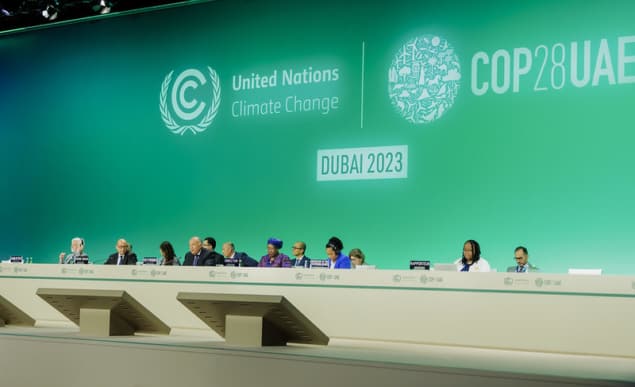
30 November and 12 December in Dubai, United Arab Emirates. (courtesy: Ministry of Environment – Rwanda)
The UN’s COP28 conference in Dubai is over. Government delegations have shaken hands, packed up and flown home. Journalists, lobbyists and campaigners have filed their last report, eaten their last canapé and filmed their final despairing or cautiously hopeful videos for social media.
For the rest of us with an interest in the future of the planet, the question now is, did the meeting make a difference?
And for physicists, the question is the same as the Institute of Physics (IOP), which publishes Physics World, posed in its recent report Physics Powering the Green Economy: will physics-powered technologies and physics-based businesses be recognised and supported as being at the heart of the solution?
In fact, we thought this was such an important issue that we took the report to the summit and posed this question there.
We’re worried because physicists are worried. When we asked IOP members as part of the report whether they think the UK is doing enough to address climate change, some 83% said “no” with 68% thinking that the current level of investment in research and development in the UK is too low to deliver the kind of growth we need in the green economy, which is essential to deliver net-zero targets.
So now the talking is over, has the COP agreement moved the dial on any of that?
The final agreed text was hailed as “historic” by its supporters given that it calls – for the first time – for a “transition away” from fossil fuels (although you would be well within your rights to wonder why that has taken so long).
But detractors point to multiple potential “loopholes” with little by the way of hard deadlines. It includes a discussion of transitional fuels such as liquified natural gas but a lack of acknowledgement over the importance of carbon-capture technologies. Some see this as providing opportunities for backsliding and evidence for the influence of vested interests.
For the IOP and the physics community, it feels that the first global commitment to transition away from fossil fuels warrants a cautious welcome. So does the reiteration of the importance of achieving net-zero by 2050 and pledges from the US and China to keep the 1.5 °C ceiling commitment alive.
It’s great to see the physics-powered technologies that the physics community have highlighted right at the heart of the global solution
That’s partly because these measures should provide those investing or working in the green economy with confidence that there will be a demand for their solutions. That will help to stimulate investment and growth in such areas.
This matters as it is businesses that will deliver the needed change at scale and pace. Indeed, the UK’s physics-based green-economy businesses are already a substantial and growing economic force. Our research shows that the 1772 businesses across the UK and Ireland that deliver green-economy technologies turn over nearly £750bn.

‘Now is the time for action’ to reach net-zero climate targets, demands IOP report
The key point in the agreement for physicists is likely the recognition that technology can play in tackling the problems we face.
The final text calls for action on a list of “zero- and low-emission technologies” including renewables, nuclear, carbon capture and storage technologies, and low-carbon hydrogen production.
The IOP report highlights almost the same list of technologies, so it’s nice to see the COP deal text agreeing with the views of the physics community. Not least because our analysis shows that 72% of recent funding for these technologies from UK Research and Innovation is related to physics.
Of course, the agreement could have been stronger and missed things the physics community feel are important. Our report finds, for example, that energy storage is a technology requiring support, but it is not specifically mentioned in the COP deal text.
It is also important to stress that there is no single silver bullet solution to the climate problem, no moonshot technology to save the day so we will need everything in our technological and scientific armoury to move the dial on climate change.
The COP28 deal, with all its flaws, shines a light on the pivotal role that physics can play in developing and delivering climate solutions
But there’s much to celebrate. It’s great to see physics-powered technologies that the physics community have highlighted right at the heart of the global solution. It’s welcome that ambition is maintained and increased – to give the market the confidence to invest for the long term – to grow and contribute to our economy.
Ultimately success or failure on the climate crisis will be determined by how quickly technology is improved through R&D and deployed by businesses.
The UK and Ireland continue to aspire to be at the forefront of this global effort. So what we now need is a renewed strategic ambition in the UK and Ireland, with physics at its heart. This includes investing in improving and deploying core technologies, supporting green-economy businesses to grow and trade internationally, as part of a broader “systems approach” to show international leadership and to make the most of the potential the deal offers.
The COP28 deal, with all its flaws, shines a light on the pivotal role that physics can play in developing and delivering climate solutions.
It’s up to us now to consider whether we are making the most of the potential of physics to power the green economy– to utilise the growing power of this physics-powered sector, to address our greatest challenge.
